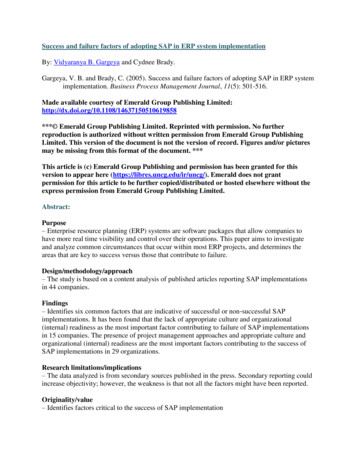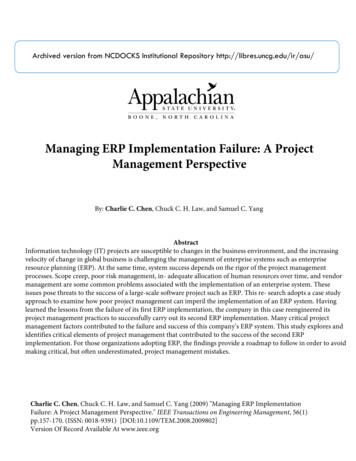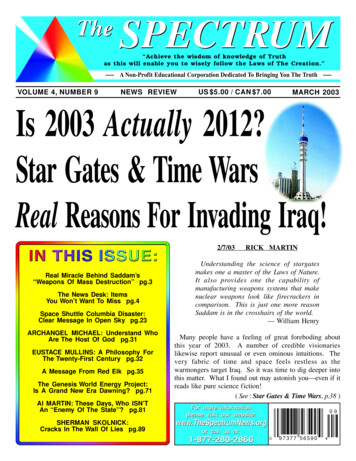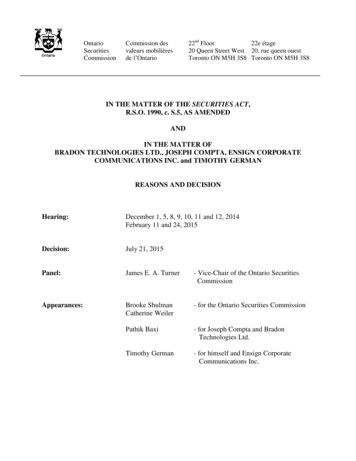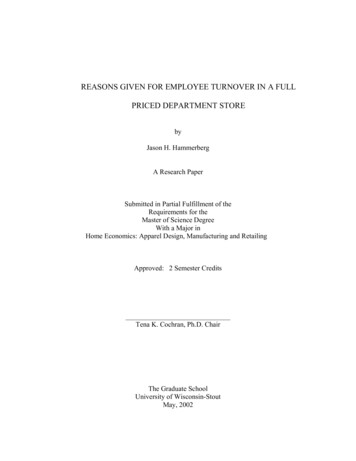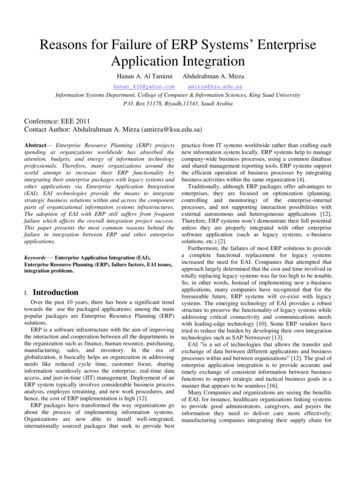
Transcription
Reasons for Failure of ERP Systems’ EnterpriseApplication IntegrationHanan A. Al TamimiHanan 430@yahoo.comAbdulrahman A. Mirzaamirza@ksu.edu.saInformation Systems Department, College of Computer & Information Sciences, King Saud UniversityP.O. Box 51178, Riyadh,11543, Saudi ArabiaConference: EEE 2011Contact Author: Abdulrahman A. Mirza (amirza@ksu.edu.sa)Abstract— Enterprise Resource Planning (ERP) projectsspending at organizations worldwide has absorbed theattention, budgets, and energy of information technologyprofessionals. Therefore, many organizations around theworld attempt to increase their ERP functionality byintegrating their enterprise packages with legacy systems andother applications via Enterprise Application Integration(EAI). EAI technologies provide the means to integratestrategic business solutions within and across the componentparts of organizational information systems infrastructures.The adoption of EAI with ERP still suffers from frequentfailure which affects the overall integration project success.This paper presents the most common reasons behind thefailure in integration between ERP and other enterpriseapplications.Keywords— Enterprise Application Integration (EAI),Enterprise Resource Planning (ERP), failure factors, EAI issues,integration problems.I.IntroductionOver the past 10 years, there has been a significant trendtowards the use the packaged applications; among the mainpopular packages are Enterprise Resource Planning (ERP)solutions.ERP is a software infrastructure with the aim of improvingthe interaction and cooperation between all the departments inthe organization such as finance, human resource, purchasing,manufacturing, sales, and inventory. In the era ofglobalization, it basically helps an organization in addressingneeds like reduced cycle time, customer focus, sharinginformation seamlessly across the enterprise, real-time dataaccess, and just-in-time (JIT) management. Deployment of anERP system typically involves considerable business processanalysis, employee retraining, and new work procedures, andhence, the cost of ERP implementation is high [12].ERP packages have transformed the way organizations goabout the process of implementing information systems.Organizations are now able to install well-integrated,internationally sourced packages that seek to provide bestpractice from IT systems worldwide rather than crafting eachnew information system locally. ERP systems help to managecompany-wide business processes, using a common databaseand shared management reporting tools. ERP systems supportthe efficient operation of business processes by integratingbusiness activities within the same organization [4].Traditionally, although ERP packages offer advantages toenterprises, they are focused on optimization (planning,controlling and monitoring) of the enterprise-internalprocesses, and not supporting interaction possibilities withexternal autonomous and heterogeneous applications [12].Therefore, ERP systems won’t demonstrate their full potentialunless they are properly integrated with other enterprisesoftware application (such as legacy systems, e-businesssolutions, etc.) [2].Furthermore, the failures of most ERP solutions to providea complete functional replacement for legacy systemsincreased the need for EAI. Companies that attempted thatapproach largely determined that the cost and time involved intotally replacing legacy systems was far too high to be tenable.So, in other words, Instead of implementing new e-businessapplications, many companies have recognized that for theforeseeable future, ERP systems will co-exist with legacysystems. The emerging technology of EAI provides a robuststructure to preserve the functionality of legacy systems whileaddressing critical connectivity and communications needswith leading-edge technology [10]. Some ERP vendors havetried to reduce the burden by developing their own integrationtechnologies such as SAP Netweaver [13].EAI ‖is a set of technologies that allows the transfer andexchange of data between different applications and businessprocesses within and between organizations‖ [12]. The goal ofenterprise application integration is to provide accurate andtimely exchange of consistent information between businessfunctions to support strategic and tactical business goals in amanner that appears to be seamless [16].Many Companies and organizations are seeing the benefitsof EAI; for instance, healthcare organizations linking systemsto provide good administrators, caregivers, and payers theinformation they need to deliver care more effectively;manufacturing companies integrating their supply chain for
more accurate inventory replenishment and better anticipationof consumer demand; and, government organizations webenabling citizens and businesses with self-services such aspermitting, tax collection, licensing, payments, and polling orvoting [3].Although the integration is a way to exchange informationin one organization automatically, it still suffers fromproblems and failures. Unfortunately, most developers andmangers consider EAI as a big challenge for the success ofsynchronizes all applications within the organization.A.Problem of the StudyIn an enterprise system, it is a critical that ERP systems andother critical application systems operate seamlessly. Gettingapplications to work with each other remains a big challenge.Problems related to integration cause great delays in enterpriseoperations. A lot of work has to be done manually, forinstance, data from one system has to be printed out and thenre-entered in a different format to a target system.Furthermore, the cost of integration is high and growing asit is not limited to installing new applications only. There aremany other expenses related to time and human resourcesassociated with the huge responsibility of maintaining andcontrolling the integrated systems. Thus, the implementationof an integration project is critical investment for anyorganization or company.According to Information Management [1] ―enterpriseapplication integration (EAI) remains one of the top priorities‖for organizations. What may surprise many, however, it thatmore than 70 percent of these EAI projects fail in some way,where failure is rated as missing deadlines, blowing budgetsor failing to deliver the service that the business wasexpecting.‖Moreover, the research of Dr. Bernard Wong and DavidTein [4] identified integration of systems as one of the CriticalSuccess Factors in ERP implementation. The 110 MillionSAP ERP implementation project of the Hershey FoodsCorporation’s had failed as a result of the improper testing ofthe integrated systems [4].IS evaluation group [14] from Brunel university, publishesthe result of an empirical survey involving ERP problems andapplication integration as follows ―Integration is anotherimportant problem of ERP Solutions, the most seriousproblems focus on the integration of the ERP solution withexisting applications such as legacy systems (82%), or withnew business software (e.g. supply chain management, ecommerce applications etc) (46%). Therefore, integration isextremely difficult to be achieved through these integratedsuites.‖From the previous studies and research we can realize theintegration of ERP requires significantly more than a simpledata exchange focus. The application integration projects withERP draw upon technical skills, business process,reengineering skills, and business acumen to discover richopportunities and avoid the failures.B.Purpose of the studyIn order to help companies succeed with their businessintegration, the study’s main objective is to identify the mostcommon causes of ERP integration failures from the differentliterature on ERP and systems integration and to present it tothe reader in an ordered and organized manner. This shouldhelp managers of such implementation projects to avoid suchproblems and the potential causes for failureII.Enterprise Application IntegrationA.What is EAI?Different definitions of EAI were found during theliterature review: ―Enterprise application integration (EAI) isthe process of linking such applications within a singleorganization together in order to simplify and automatebusiness processes to the greatest extent possible, while at thesame time avoiding having to make sweeping changes to theexisting applications or data structures‖ [6]. EAI is alsodefined as ―unrestricted sharing of information between twoor more enterprise applications. A set of technologies thatallow the movement and exchange of information betweendifferent applications and business processes within andbetween organizations‖ [10].In general, systems integration in an enterprise can takeplace on different levels in an IT system. Many technologiesand tools fit into one of these levels. Currently, the new trendin the industry towards IT applications achieving multipleintegration levels [7]. In the data integration level, theintegration takes place between data stores. Data is extractedfrom one site’s database and used to update another system’sdatabase after suitable data formatting modifications. Theapplication interface integration level is an interface that givesaccess to three types of services including business, data, andobjects provided by a custom system or a standard package. Inthe method (business process) integration level, theapplications are integrated through the enablement of thesharing of a set of common methods. In user interfaceintegration levels, also known as ―screen scraping,‖applications are integrated through the user interfaces, i.e.information are accessed from user screens by programmaticmechanisms [7, 10].The infrastructure of Application integration is based on aset of technologies that allows information to be exchangedbetween different systems and business processes within andbetween organizations like remote procedure calls (RPCs),message oriented middleware (MOM), distributed objects,database oriented middleware, XML, and, enterprise servicebus (ESB), etc.B. ERP Integration OptionsThe integration between different systems such as legacy,e-commerce and other applications with ERP suites fromvendors like SAP AG, PeopleSoft, Oracle, J.D Edwards, andMicrosoft Dynamic can be performed in different ways. Eachintegration approach has its own challenges and limitations.
1) ERP APIs today: ERP vendors are providing theirsoftware with low-level APIs that support simple data access.If the data is going to be shared between two or three ERPmodules, this approach can work very well. The drawback ofthis option is that APIs in general work well in providing dataaccess but not in providing integration of business processessuch as workflow.2) Data-Sharing Tools: A Number of tools are available inthe market for facilitating simple data sharing between ERPpackages and other applications, such as manufacturingapplications.TABLE IORGANIZATIONAL PROBLEMSReasonCategoryManagement and Cost IssueThe options vary from off-the-shelf data-sharing productssuch as middleware, EAI tools and ERP connectors to develophome-grown connector components, or applicationprogramming interfaces (APIs) available within the ERPsystem. Depending on what the systems we are working tointegrate and the level of integration, developers can use oneof the following options[15]:Ref.[5] The implementation of EAI is expensiveand more complex than expected.[11] The nature of EAI is dynamic andrequires dynamic project managers tomanage these changes.[8] The cost of EAI project could be 5 to 7times higher than other IS projects. Top management often does notunderstand what exactly the cost ofintegration is.[16] Management by magazine where thedecisions are made without performingan appropriate analysis. The need to obtain and maintainsponsorship and financial commitment atall levels of the organization for theduration of a potentially lengthy project.[5] At the initial implementation ofIntegration Project, the entitlements areoften not considered. EAI integratemultiple existing applications, each ofwhich supports its own security, asuitable entitlements system must be inplace in the beginning of implantation.[11] Change is constant; the frequent changerequires changes in different componentsthat spread across different companies.[8] Inflexible plan for changing within theimplantation. Managementusuallydoesnotunderstand that integration is not a onetime activity or a singular success. The lack of appropriate change planrepeatedly leads to rejection of the EAIstrategies.The failure of enterprise application integration is not asmall problem; it is a critical factor for the success of theentire organization. In general, it is important to know whatdoes failure mean? from the previous studies we can answerthis question as follow: If the EAI solution runs lessefficiently than the old systems it replaced (end to endtransaction), it will be deemed a failure, or EAI project goesover budget, or produces less-than-hoped-for results, or anycombination of these cases, the EAI solution will beconsidered to have failed [10, 11].In this paper we have summarized the reasons for failurediscussed in related works and categorized them, based ontheir potential for occurrence during the EAI project life plementation problems, architecture & design problems,and, operational problems.Organizational problems include issues related tomanagement and cost, planning, scope, communication,business prospective, and user resistance (Table 1).ScopeDefinitionof FailureCommunicationIII. CausesPlanning Issue3) Transactional Integration Tools: Due to the increasingneed for corporate ERP systems to work with different ERP,e-commerce and e-procurement application platforms outsidea company, transactional infrastructure is important in thiskind of integration. The drawback of this option is thatfirewalls will not be adequate.4) Sticking with Standards: The developer mus
SAP ERP implementation project of the Hershey Foods Corporation’s had failed as a result of the improper testing of the integrated systems [4]. IS evaluation group [14] from Brunel university, publishes the result of an empirical survey involving ERP problems and application integration as follows ―Integration is another important problem of ERP Solutions, the most serious

